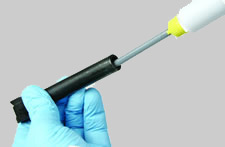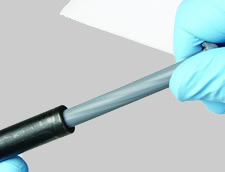- 01: Introduction
- 02: History
- 03: Propellants, Firearms, and Ammunition Development
- 04: Modern Firearms Manufacture
- 05: Small Arms Ammunition
- 06: Evidence Handling Procedures
- 07: Equipment and Instrumentation
- 08: Examination of Firearms
- 09: Cartridge and Shotshell Examination
- 10: Characterization and Evaluation of Fired Projectiles
- 11: Bullet Comparison and Identification
- 12: Gunshot Residue and Distance Determination
- 13: Toolmark Identification
- 14: Communicating Results
- Resources


Test Firing
Home > Examination of Firearms > Examination > Test Firing

Steps in casting a barrel
Laboratory policies and procedures should be followed for test firing. If there are any concerns about the safety of the firearm, a remote firing system should be used.
The following is a general description of the process to be performed and documented for function and bullet recovery test firing:

Steps in casting a barrel
- Function.
- Load firearm with one cartridge.
- Announce intention to fire.
- Discharge firearm.
- Bullet recovery.
- Properly mark cartridge case and bullets.
- Determine appropriate recovery medium (water, cotton, etc.).
- Load firearm with one marked cartridge.
- Place the firearm into the recovery system firing opening.
- Announce intention to fire.
- Discharge the firearm.
- Repeat steps c – f until number of test fires required (by laboratory policy) is complete.
- Recover bullets and cartridge cases.
- Additional Testing.
- Full automatic firing.
- Single-action.
- Double-action operation.
| Note: |
| When testing for firearm function of semiautomatic pistols and full automatic firearms, more than one cartridge should be used. Laboratory protocol should be followed for this functionality testing. |
| Special Considerations | |
Revolvers |
In double-action revolvers with the capability of operating in single- or double-action mode, test fires should be obtained using both modes; markings may vary depending on the mode of discharge. |
Multi-barreled firearms |
In multibarrel firearms, each barrel must be test fired; marked bullets/cartridges must be readily identifiable back to the barrel and breech that discharged them. |
Rifles |
High-powered rifles can present difficulties in the recovery of fired bullets due to potential bullet fragmentation. Refer to laboratory policy for the correct methodology. |
Firearms unsafe to discharge |
Using casting material, cast the barrel or the breech face firing area to provide microscopic detail for examination and comparison. |

Click here to read more on casting in Module 11.




